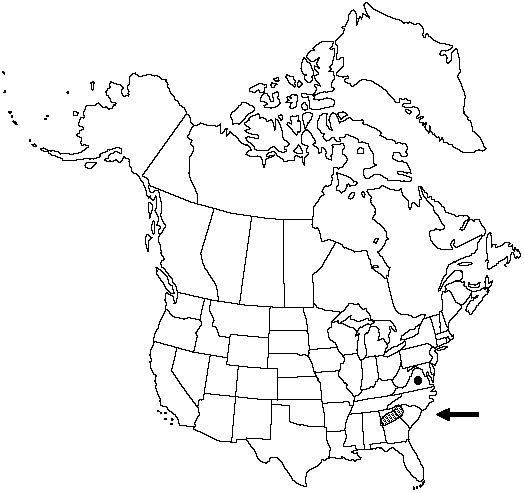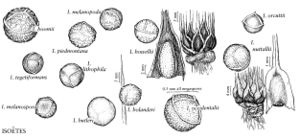Difference between revisions of "Isoëtes virginica"
Claytonia 3: 29. 1937.
Common names: Virginia quillwort
Synonyms: Isoëtes virginica var. piedmontana N. E. PfeifferIsoëtes piedmontana unknown
Treatment appears in FNA Volume 2.
FNA>Volume Importer |
FNA>Volume Importer |
||
| Line 23: | Line 23: | ||
}}<!-- | }}<!-- | ||
| − | --><span class="statement" id="st- | + | --><span class="statement" id="st-undefined" data-properties=""><b>Plants </b>becoming terrestrial. <b>Rootstock</b> nearly globose, 2-lobed. <b>Leaves</b> deciduous, dull green, pale to dark brown toward base, spirally arranged, less than 30 cm, pliant, gradually tapering to tip. <b>Velum</b> covering less than 1/3 of sporangium. <b>Sporangium</b> wall brown-streaked to completely brown. <b>Megaspores</b> white, 400–480 μm diam., boldly tuberculate to rugulate with cristate, occasionally branched to anastomosing ridges; girdle obscure. <b>Microspores</b> light brown in mass, 27–33 μm, spinulose. <b>2n</b> = 22, 44.</span><!-- |
-->{{Treatment/Body | -->{{Treatment/Body | ||
| + | |phenology=Spores mature late in spring–early summer. | ||
|habitat=Mud flats and depressions on and around granite outcrops | |habitat=Mud flats and depressions on and around granite outcrops | ||
|distribution=Ala.;Ga.;S.C.;Va. | |distribution=Ala.;Ga.;S.C.;Va. | ||
| Line 44: | Line 45: | ||
|basionyms= | |basionyms= | ||
|family=Isoëtaceae | |family=Isoëtaceae | ||
| + | |phenology=Spores mature late in spring–early summer. | ||
|habitat=Mud flats and depressions on and around granite outcrops | |habitat=Mud flats and depressions on and around granite outcrops | ||
|distribution=Ala.;Ga.;S.C.;Va. | |distribution=Ala.;Ga.;S.C.;Va. | ||
| Line 50: | Line 52: | ||
|publication year=1937 | |publication year=1937 | ||
|special status= | |special status= | ||
| − | |source xml=https://jpend@bitbucket.org/aafc-mbb/fna- | + | |source xml=https://jpend@bitbucket.org/aafc-mbb/fna-data-curation.git/src/9216fc802291cd3df363fd52122300479582ede7/coarse_grained_fna_xml/V2/V2_253.xml |
|genus=Isoëtes | |genus=Isoëtes | ||
|species=Isoëtes virginica | |species=Isoëtes virginica | ||
| − | |||
| − | |||
| − | |||
| − | |||
| − | |||
| − | |||
| − | |||
| − | |||
| − | |||
| − | |||
| − | |||
| − | |||
| − | |||
| − | |||
| − | |||
| − | |||
| − | |||
| − | |||
| − | |||
| − | |||
}}<!-- | }}<!-- | ||
-->[[Category:Treatment]][[Category:Isoëtes]] | -->[[Category:Treatment]][[Category:Isoëtes]] | ||
Revision as of 13:15, 27 July 2019
Plants becoming terrestrial. Rootstock nearly globose, 2-lobed. Leaves deciduous, dull green, pale to dark brown toward base, spirally arranged, less than 30 cm, pliant, gradually tapering to tip. Velum covering less than 1/3 of sporangium. Sporangium wall brown-streaked to completely brown. Megaspores white, 400–480 μm diam., boldly tuberculate to rugulate with cristate, occasionally branched to anastomosing ridges; girdle obscure. Microspores light brown in mass, 27–33 μm, spinulose. 2n = 22, 44.
Phenology: Spores mature late in spring–early summer.
Habitat: Mud flats and depressions on and around granite outcrops
Distribution

Ala., Ga., S.C., Va.
Discussion
Short plants with 15 to 50 leaves and a tendency toward lower and more open megaspore ornamentation have been called Isoëtes virginica var. piedmontana Pfeiffer.
Selected References
None.
Lower Taxa
None.
